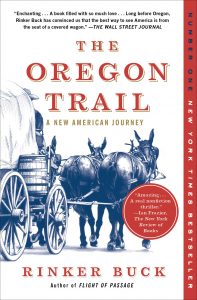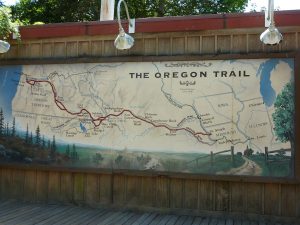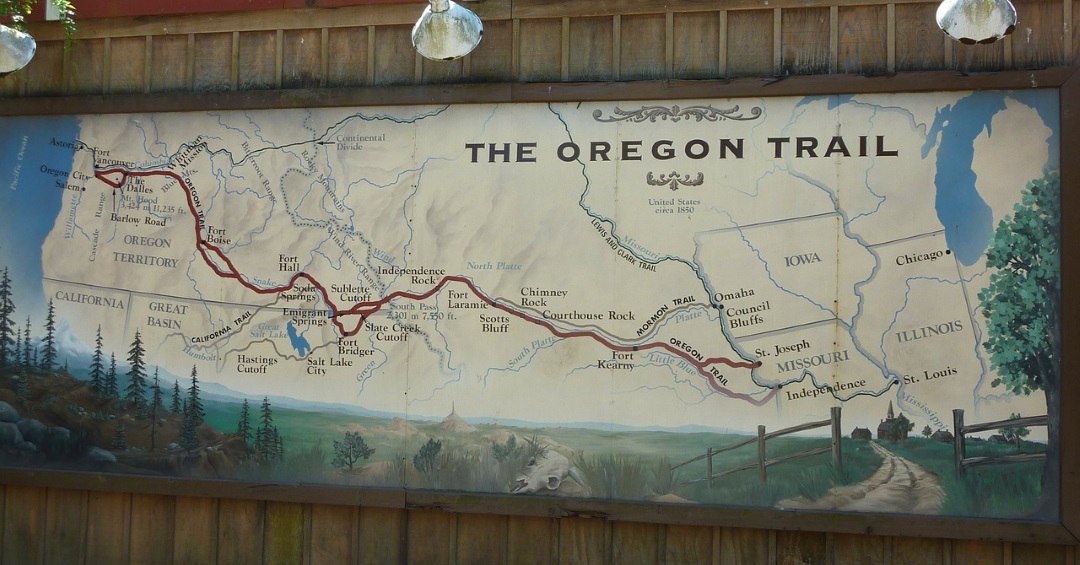Water Closet for October 20, 2017
The old saw “The devils are in the details.” is carried to a high level by dreamers Rinker and Nicholas Buck. Unlike many dreamers their dreams don’t get in the way of practicality and can-do attitudes. [pullquote]”They, Olive Oyl, and the mules Jake, Bute, and Beck made a diverse and lovable team as they cross the 21st century continent in mid-19th century style on roughly the same paths as the pioneers headed for Utah, California, Idaho and Oregon did”[/pullquote] Claudia Johnson, retired Middleton librarian, put the Old Closeteer and others on to Rinker’s 2015 book The Oregon Trail. This New York Times best seller is an account of his trip over 2000 miles long in a mule drawn wagon on a route often wide with many short-cuts called the Oregon Trail. Rinker Buck, a crackerjack writer and historian, with sharp eyes, sharper ears and a good sense of humor brings historical details easily to trail life. He, newspaperman and freelance writer, might object to being called a historian. Buck is certainly not one of the academic types, although he could have been had he so chosen. As a long time reporter he seems to deeply understand how America works now and did in the past. He might approve of Bill Clinton’s campaign slogan, “It’s the economy stupid.” Substitute “money,” the word on the street for economy, in this sentence.

Best selling book by Rinker Buck about his 21st century 2000 mile journey on the Oregon Trail. The Buck party was made up Rinker, brother Nicholas, dog Olive Oyle, and three mules, Jake, Bute, and Beck. – courtesy of internet
Upper middle age, after living what to the rest of us would seem several lives, Rinker sees some of the famous wheel ruts of the Oregon Trail made by tens of thousands of wagons pulled mostly by mules. Inspired by a family horse drawn wagon trip in Pennsylvania organized by his father for a summer vacation in 1978, he decides to repeat that trip with one a hundred times longer and rougher by retracing the 19th century Oregon Trail in a wagon pulled by mules. His amazing brother Nicholas, contractor, mechanic, animal lover, actor and raconteur from Maine, insisted on going along bringing with him his beloved, stinky, dog Olive Oyl. It would take Rinker a separate book to describe self educated genius Nicholas who knows everything useful and is much loved for his stories, helpfulness and enthusiasm. Nick, Jack of all trades and master of many needed on such a journey, was accepted with delight and not a little apprehension by his more orthodox brother although the word orthodox is an oxymoron with these guys. Nick has marched quick-step throughout life, very much his own drummer. Tidy Rinker, while well educated and equally energetic, is more cautious. They, Olive Oyl, and the mules Jake, Bute, and Beck made a diverse and lovable team as they cross the 21st century continent in mid-19th century style on roughly the same paths as the pioneers headed for Utah, California, Idaho and Oregon did. Rinker engagingly in day to day detail tells of the Bucks’ journey from May to October and much more about our country. He weaves the stories of the Buck journey with those of the gutsy, many desperate pioneers who participated, probably unknowingly, in the spirit of Manifest Destiny. The spirit of those pioneers carries over today in the “Red States” according to Rinker. There rugged individualism is held in high esteem. Historically, that characteristic, so much touted by westerners, is “utter bunk” in Buck’s opinion. Our legendary movement west was, from the 1840s on, much subsidized by the Federal Government. Wyoming, a central Oregon Trail state still receives massive amounts of Federal help relative to its sparse population and yet claims in campaign slogans not to want aid. The rugged and friendly individuals the Buck party encountered on the trail made their trip a delight because of their interest in the wagon adventure and their natural generosity. Many ranchers went miles out their way to help with repairs, guidance, hay, food, company, and pasture. One ornery couple who were inhospitable became eternal villains in the print of this popular book. Thousands that did the trail for real in the 1800s were taken advantage of by sharp traders profiting from migration. The Bucks experienced this in a small way when they purchased their two wagons. The “jump off” towns along the Missouri and the many “camp towns” along the trail were wild, rough places where many cheated the newcomers. Much valued household goods left behind to lighten loads littered the trail from end to end. Entrepreneurs recycled them. Many people died en route under wheels or as victims of cholera. The skeletons of cattle, horses and mules were found all along the trail. Shallow human graves were common. Even the 21st century Bucks left a few unnecessary things behind. A constant problem for them and the early Oregon bound pioneers was water, too much at swollen rivers and streams and too little for long stretches in the deserts west of Nebraska. Without large parties with many animals the Bucks’ biggest challenges were steep grades on sometimes narrow rough paths. They had no gangs of people to help them.

The Oregon Trail, the paths of tens of thousands of pioneers and animals in their difficult 19th century treks west. – courtesy of internet
Librarian Claudia’s best pitch when putting the Closeteer and others on to this book was “I frequently laughed out loud.” The Closeteer also laughed while learning much more than he had before about our country. The details Rinker so loves from the pioneers’ letters, maps and journals were intertwined with what the Buck party experienced and observed along the trail. Mule and human behavior and the harnesses and rigs connecting them are well and at times of stress dramatically described. Rinker, Nicholas, Olive, and the mules are emotional cusses and Rinker often lets it all hang out in entertaining and at times disturbing ways. The laughing, and almost crying parts at times, come from the relationship between the two loving but very different brothers and an occasional visit by their father’s ghost to Rinker. Take the Oregon Trail with the Bucks; you can do so in your reading chair without fear of running out of water for the mules. Better still after reading get your own team and wagon before it’s too late. Don’t use an RV. Rinker doesn’t think much of the big rigs and clueless occupants who visit historical sites. He isn’t at all shy about expressing such opinions or exaggerating as he dramatizes the hazards of the trail encountered. Exaggeration is perhaps unfair. It took courage and persistence to do the trail without a large company of other wagons as most all did in the old days without roads, rail, law, or communication other than mail that took months. Rinker should be allowed a few tall tales told in perfect sentences.
His descriptions of the spectacular trail and surrounds are terrific. He contrasts them with those from old letters and journals.
Nicholas blurts out at one point on a western Wyoming desert while approaching the lovely meanders of the Green River seen below, “I don’t ever want to go back home. I want to live in this wagon the rest of my life.” He must have been sincere because for a change he leaves out his usual f – words.
___________________________________________________________
WATER RESOURCE AND CONSERVATION INFORMATION
FOR MIDDLETON, BOXFORD AND TOPSFIELD
| Precipitation Data* for Month of: | July | Aug | Sept | Oct | |
| 30 Year Normal (1981 – 2010) Inches | 3.89 | 3.37 | 3.77 | 4.40 | |
| 2017 Central Watershed Actual | 3.43 | 1.22 | 3.2 | 0.6 as of Oct 13 | |
Ipswich R. Flow Rate (S. Middleton USGS Gage) in Cubic Feet/ Second (CFS):
For Oct 13, 2017 Normal . . . 8.8 CFS Current Rate . . . 2.19 CFS
—————————————————————–
*Danvers Water Filtration Plant, Lake Street, Middleton is the source for actual precipitation data thru Aug.
** Middleton Stream Team is the source of actual precipitation data for Sept and Oct…
Normals data is from the National Climatic Data Center.
THE WATER CLOSET is provided by the Middleton Stream Team: www.middletonstreamteam.org or <MSTMiddletonMA@gmail.com>


Very great post. I simply stumbled upon your blog and wanted to say that I’ve really enjoyed surfing around your blog posts.
After all I’ll be subscribing to your rss feed and I am hoping you write once more soon!
My web site :: 꽁머니
Do you mind if I quote a few of your posts as
long as I provide credit and sources back to your site?
My website iss in the very same niche as
yours and my visitors would genuinely benefit from a lot
of the information you proovide here. Please let me know if this
ok with you. Regards!
Jogue o jogo Aviator por dinheiro cassino online com dinheiro real
Any onljne casino value its salt will provide players
wiyh a generous collectin of promotions. Despit the declining usage of this
know-how, Flash remains to be wanted to play most of the ggames you’ll bbe able to tryy
out on our website. This service was started by The National Online Self-Exclusion Scheme Limited.
Have you ever considered writing an ebook or guest authoring on other blogs?
I have a blog centered on the same ideas you discuss and would love to
have you share some stories/information. I know my subscribers would enjoy your work.
If you are even remotely interested, feel free to send me an e mail.
Check out my site – 먹튀검증사이트
The excellent news is that anxiety is treatable and there’s a variety of medications and psychotherapy
strategies to control and get rid of most forms of anxiety disorders Apart from Xanax and its peers, there are drugs like beta-blockers, Buspirone.
jss777 hello my website is jss777
voxto hello my website is voxto
upslike hello my website is upslike
đom đóm hello my website is đom đóm
uebs hello my website is uebs
bac66 hello my website is bac66
Savett hello my website is Savett
bafood hello my website is bafood
js混淆 hello my website is js混淆